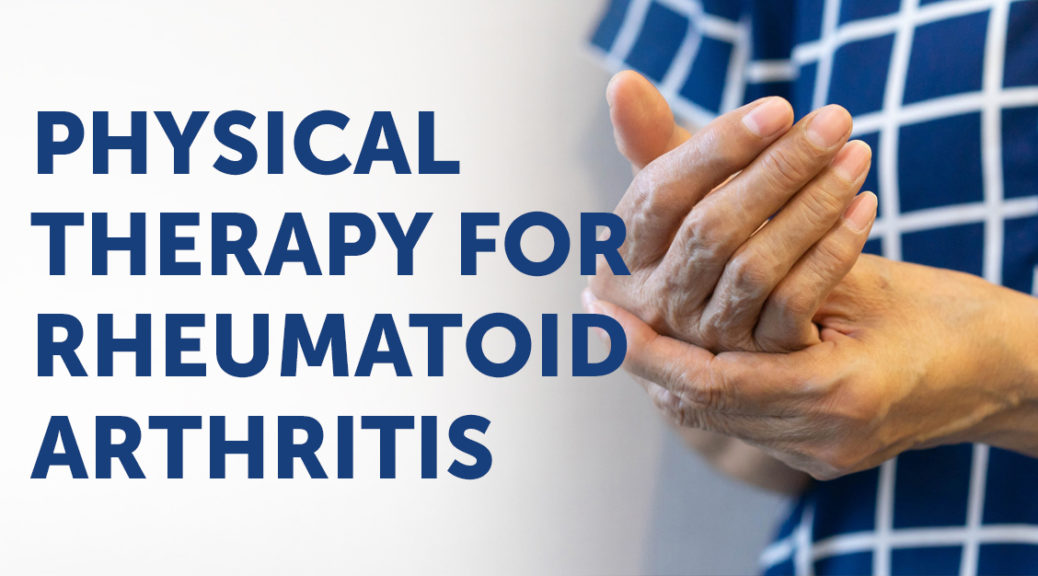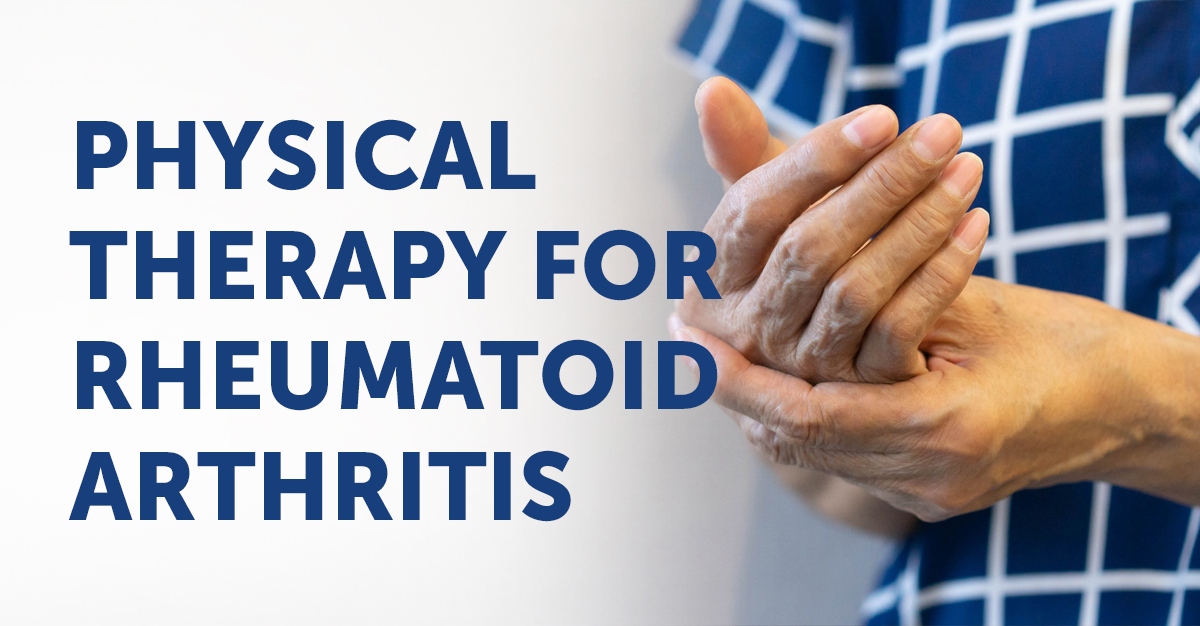
What is Rheumatoid Arthritis (RA)?
Rheumatoid Arthritis (RA) is a chronic inflammatory and autoimmune disease that has the potential to impact many different joints and organs in the human body. RA can cause inflammation and swelling in the joints. While medications are necessary in most cases to help slow the progression of RA, programs such as physical therapy can relieve the symptoms and improve the overall quality of life when living with RA
How Does RA Happen?
While there are many different types, Rheumatoid Arthritis is the most common form of autoimmune arthritis. This disease occurs because of a faulty immune response that causes the body to attack its tissue. Specifically, RA attacks the lining, or synovium, of a joint, leading to swelling and eventually erosion in the joint itself over time.
While in the early set stages, RA typically affects the smaller joints in your body such as the hand, wrist, and toes. However, as RA progresses, larger joints including the knees, hips, and shoulders along with vital organs such as the heart, lungs, and eyes can also be impacted.
Benefits of Physical Therapy for Rheumatoid Arthritis
While Rheumatoid Arthritis can have an effect on the joints and organs of the body, physical therapy can provide several meaningful benefits. Physical therapy can help ease symptoms and enhance your quality of movement, making everyday life easier for people suffering from RA.
When seeing a physical therapist about pain resulting from RA, a therapist will evaluate your posture, muscle imbalances, and the overall mechanics of your body. They’ll teach you to improve how to move to prevent injury and reduce pain.
Your therapist can also create a customized stretching and exercise plan that helps ease pain, increase your range of motion, and improve your movement patterns.
Things that physical therapy can do to help with RA include:
- Create a HEP (Home Exercise Program)
- Improve your overall level of fitness
- Increase your endurance
- Help eliminate stiffness in your joints
- Decrease fatigue
- Improve your balance and stability
- Increase coordination
Other Physical Therapy Treatments for Rheumatoid Arthritis
There are passive ways that PT can help with rheumatoid arthritis. A physical therapist performs these treatments.
Massage Therapy
This relaxing treatment can help target specific muscles and release tension. Massage can also stimulate healthy blood circulation and manage stress.
Note that massage therapy is not recommended for painful joints during a rheumatoid arthritis flare-up.
Hydrotherapy
This type of therapy involves submerging the affected area or the whole body into warm water to relieve arthritis pain.
Hydrotherapy can be passive therapy or active therapy. Some physical therapists assist rheumatoid arthritis patients in performing light movements and exercises in the water.
Cryotherapy Therapy
This therapy is performed by putting a cold compress on the affected area to reduce swelling and help alleviate pain.
Heat Therapy
Heat therapy is done by placing a warm towel on the affected area to promote circulation. This therapy may also stimulate blood flow and soothe muscle tension and pain.
Ultrasound
Therapeutic ultrasound uses vibrations from sound waves to reduce stiffness and pain, improving joint function.
For help with your arthritis pain please reach out to a physical or occupational therapist near you. We can work to manage your symptoms and still keep you doing the activities you love most!
Exercises to Help with Rheumatoid Arthritis
Many people with RA tend to avoid exercise, as they are worried that the activity might worsen their pain. However, exercise is a key treatment to help reduce the disability often associated with RA.
Regular exercise can produce stronger muscles that can better support the joints and improve flexibility which can aid joint function. Regular exercise can also reduce fatigue and boost your mood. Better overall fitness helps prevent heart disease and diabetes, two life-shortening ailments that often accompany RA.
Some low-intensity exercises are recommended for people with rheumatoid arthritis.
Walking
Low-impact and straightforward exercises are great for rheumatoid arthritis. Make sure to start your pace slowly and constantly drink water to stay hydrated. Walking promotes aerobic conditioning and boosts your mood.
Stretching
Stretching can help reduce joint stiffness, promoting flexibility among people with rheumatoid arthritis. Developing a stretching routine may help improve your range of motion. You can start your stretching routine with a warm-up for three to five minutes and proceed with mild stretching. Remember to hold the stretch for 10 to 20 seconds before releasing the stretch. You can repeat each stretch exercise two to three times.
Cycling
Low-impact aerobic exercises like cycling benefit the joints. Cycling may have beneficial effects on your cardiovascular health, which may be at risk when you have rheumatoid arthritis. You can ride a bike outside or cycle on a stationary bike with the supervision of a physical therapist.
Yoga
Building your strength through these low-intensity exercises may increase your muscle strength and joint flexibility. These activities encourage flowing movements and deep breathing that are also advantageous for balance to avoid falls.
Safety Tips for Exercising with Rheumatoid Arthritis
Exercising is beneficial for RA if you do it safely. Before beginning, consult your physical therapist. They can recommend appropriate exercises and suggest techniques that can subside your pain.
Some safety tips for exercising with RA include:
Make sure to stretch: Warm up before each session and end by cooling down. Stretch all the major muscle groups before working out, especially the joints in your body that are prone to pain and stiffness.
Take it slow: Start with short workouts, build up your endurance, and work within your limitations. Listen to your body, especially if you are going through a flare-up, and take as many breaks as necessary. Allow yourself plenty of rest between workouts.
Do low-impact exercises: Low-impact exercises reduce stress and pressure on the joints. These exercises include swimming, walking, cycling, yoga, and many more. Avoid any workouts that cause severe pain or worsen your symptoms.
Here are some helpful hand stretches that you can try.
Patients with RA present differently and may benefit from an appointment with a hand or physical therapist. Here are some general stretches that may help.
(Images Provided by The Hale Hand Center)
- Making a Fist
Start this simple exercise by stretching out your hand with your fingers straight, and then slowly draw them together to form a fist. Make sure that your thumbs are not tucked under your fingers. Hold the fist for a minute and repeat it as many times as you want.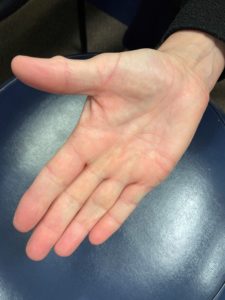
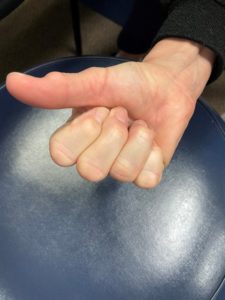
- Touching Fingers
Start by opening your hand again. Move your thumb to touch each finger lightly.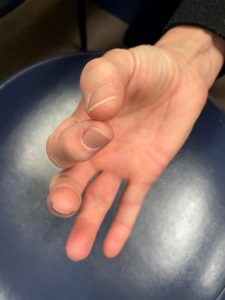
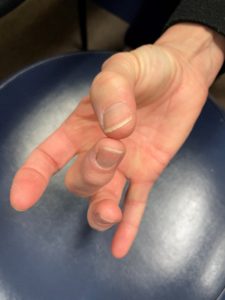
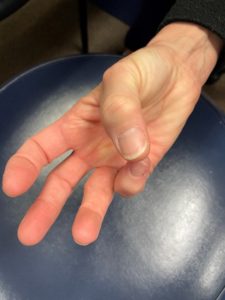
- Lifting Your Fingers
Place your hand facing down on a flat surface. One by one, slowly lift each of your fingers, starting from your thumb to your pinky. Hold the finger lift for a second or two before lowering it.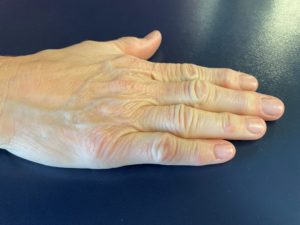
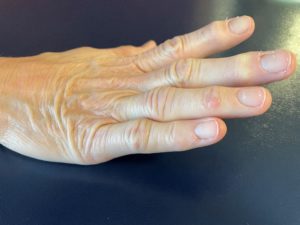
- Stretching Fingers
You can do this stretch by slowly and gently opening your hand and stretching out your fingers for several seconds. This stretch can strengthen the muscles and reduce the stiffness of finger joints.
For help with Rheumatoid Arthritis, please reach out to a physical or occupational therapist near you. We can work to manage your symptoms and keep you active so you can continue living life to the fullest and doing the activities you love most!

